Maternity care survey 2018: national results
National results of the 2018 Maternity Care Survey. Comparisons have been made with the previous iterations of this survey where this is possible.
This document is part of a collection
4. Demographic and Health Information from Survey Respondents
As the survey is a voluntary sample survey, it is important to consider the results in the context of the demographics of respondents. This chapter provides a summary of demographic information for survey respondents, either self-reported through the survey or linked to from other data sources[12]. Analysis in this chapter is based on unweighted data unless otherwise noted.
Further analysis examining the relationship between the survey results and different groups of respondents will be carried out and reported separately.
Age
The majority of respondents were between 25 and 34 (61 per cent). Only ten per cent of respondents were under 25, with the remainder being 35 and over (Figure 4.1). This is consistent with the age breakdowns from the 2015 survey, however provisional national data on maternal age in 2018[13] suggests that mothers aged under 25 are under-represented in the survey as they make up almost one in five maternities in a year (18 per cent). Conversely, mothers aged 35 and over are over-represented by a similar factor.
Figure 4.1: Age group
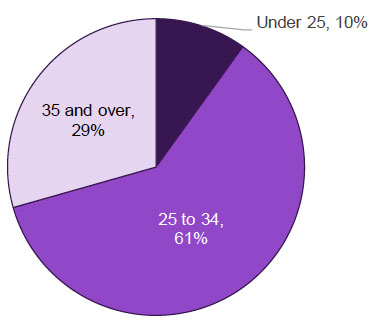
Ethnicity
The vast majority of women responding to the survey described their ethnic group as white (95 per cent). Three per cent of respondents described their ethnic group as Asian, Asian Scottish or Asian British and the remaining respondents were spread across the other ethnic groups.
Maternity Information
Almost all women responding to the survey had given birth to a single baby (99 per cent), with one per cent of respondents giving birth to twins and no respondents having triplets, quads or more.
Over half of respondents were between 37 and 40 weeks when their baby was born (55 per cent). Only six per cent of respondents were less than 37 weeks and the remaining 39 per cent were more than 40 weeks when they gave birth (Figure 4.2).
For half of the women responding (51 per cent), this experience was the first time they had given birth. Just under half of respondents (46 per cent) had given birth to one or two babies before and three per cent of women had previously given birth to three or more babies (Figure 4.3).
Figure 4.2: No. of weeks pregnant when baby was born
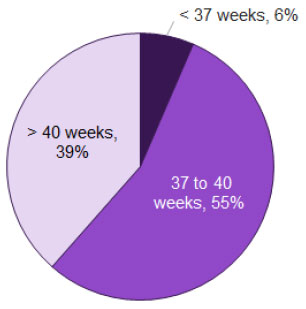
Figure 4.3: No. of babies given birth to previously
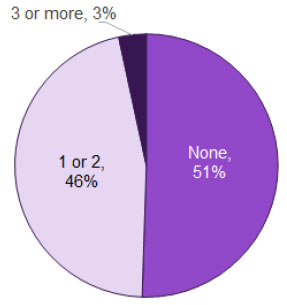
Health Information
Respondents were asked to rate both their physical and emotional / mental health before pregnancy, during pregnancy and now (2 to 7 months since giving birth).
As shown in Figure 4.4, 92 per cent of women rated their physical health as ‘Excellent’ or ‘Good’ before pregnancy. This decreased to 70 per cent when asked about their physical health during pregnancy, with ten per cent of women reporting their physical health as ‘Poor’ or ‘Very poor’. Thinking about their physical health now, 79 per cent of women responded ‘Excellent’ or ‘Good’ and only three per cent selected ‘Poor’ or ‘Very poor’.
A similar pattern was seen in responses about emotional / mental health, however the decrease during pregnancy was smaller, only dropping to 80 per cent from 91 per cent before pregnancy. There was also a smaller increase in those responding ‘Poor’ or ‘Very poor’, to five per cent during pregnancy. Thinking about their emotional / mental health now, 82 per cent of women responded ‘Excellent’ or ‘Good’ and only three per cent selected ‘Poor’ or ‘Very poor’.
Figure 4.4: Proportion of women rating their health positively
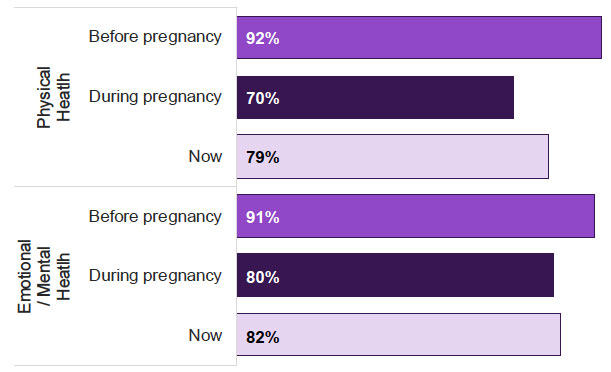
Just under one-fifth of respondents said that they had one or more long-term health conditions (17 per cent). The most commonly reported conditions were a mental health condition (reported by seven per cent of women) and chronic pain lasting at least three months (reported by four per cent of respondents).
Deprivation and Rurality
Analysis of the Scottish Index of Multiple Deprivation (SIMD)[14] and Urban/Rural Indicator[15] was based on the datazone of respondents home address. Respondents were fairly evenly distributed across SIMD quintiles, apart from the most deprived quintile which had a lower proportion of respondents (Figure 4.5).
Figure 4.5: SIMD quintile
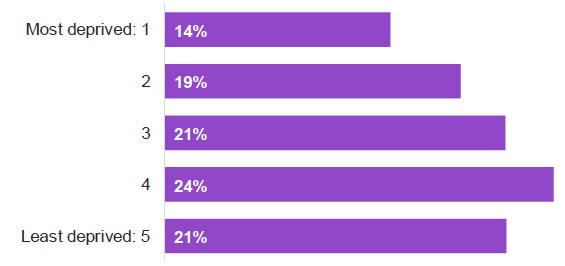
The distribution of respondents by rurality (Figure 4.6) is broadly in line with that for the population as a whole.
Figure 4.6: Urban-rural category
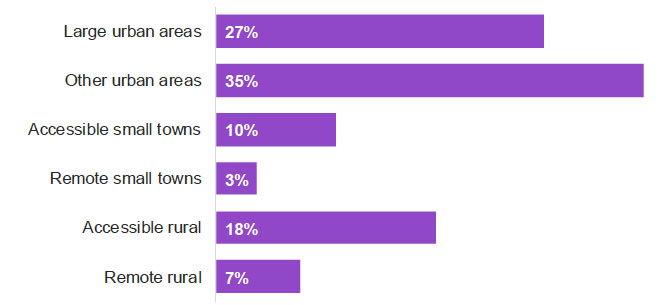
Contact
Email: patientexperience@gov.scot
There is a problem
Thanks for your feedback